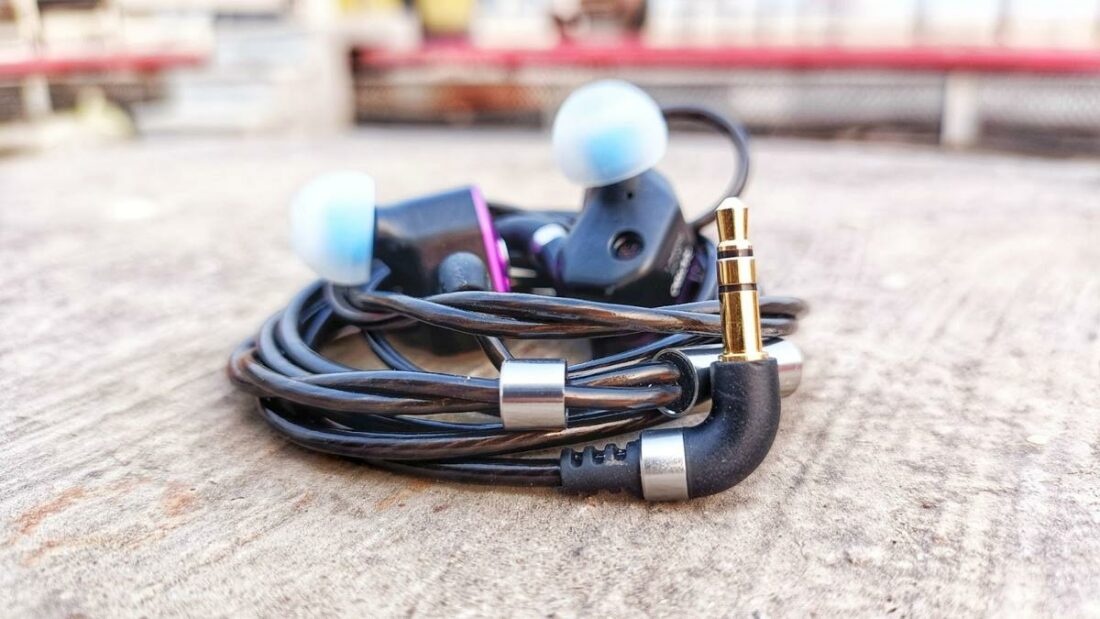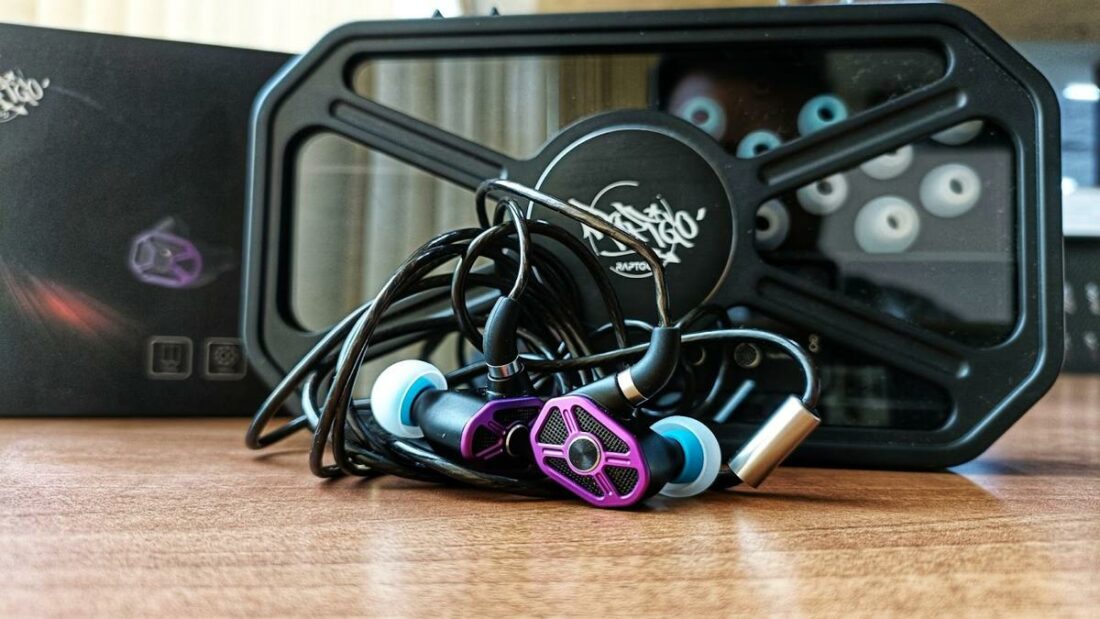The analytical sound sacrifices a bit of musicality in the process.
- Nicely textured bass, transparent midrange, and sparkling treble
- Well-defined and highly detailed notes
- Wide and deep soundstage with accurate imaging
- Nice soft and supple cable
- Multiple tuning options – switches and nozzles
- Bass lacks weight, compromising macrodynamics
- Compressed soundstage height
- Somewhat shouty upper-mids and lower treble
- Storage case not suitable for daily carry
- Not very cohesive
Raptgo originally came into focus with a planar magnetic and piezoelectric (PZT) hybrid IEM offering – the Hook-X. The budget audiophile community warmly received them. The Bridge are their newest release, a tribrid of DD, BA, and PZT drivers. I must say this is an exciting combination in the sub-USD $160 price range.
Unboxing and First Impression
Design and Build
The Bridge are surprisingly small in size, considering the number of drivers they pack inside. The shape is a somewhat unconventional oblong octagon. While the length is average, they are fairly thick to house all drivers. The semi-open back shells are built strong and sturdy.
Despite the semi-open back construction, there is barely any external sound leakage.
There is a grill on the back of the earphones protected by the octagonal faceplate. The internal PZT driver can be seen through the grill. On the inside, there are two vents, one small and near the nozzle, the other big and away from the nozzle. The tuning switches are housed on the side below the 2-pin connector.
The Bridge include with three pairs of removable nozzle filters: Black, Gold, and Silver. The black filters come attached to the IEMs, whereas the gold and silver are separately mounted on a small metal plate. The filters are screwed on the nozzles to change the sound.

Filters
The black filter is the standard listening mode, the gold filter enhances treble, and the silver filter provides a balanced sound. The gold filter has the brightest tuning. The silver filter has the least brightness and the most bass. The black filter is somewhere in between. The differences are not night and day but distinct nonetheless.
Tuning switches
Tuning switch 1 adjusts the treble intensity, and tuning switch 2 controls high and low gain modes. With switch 1 up, there is a slight boost in the lower treble energy, making this section a tiny bit more prominent.
Switch 2 changes between standard mode and high gain mode. In standard mode, the impedance is 17 Ohm, and the sensitivity is 105 dB SPL/mWd. The high gain mode is 34 Ohm/109 dB SPL/mW. I find that in high gain, the sound becomes slightly fuller.

Cable
The cable has a glossy TPU sheath that is very soft and pliable but can sometimes get tangled. There are no microphonics. The angled plug is an additional bonus and protects the cable from accidental damage. The 1.2m length is sufficient.
The supple and lightweight cable assures a comfortable wearing experience.
Comfort
The fit can be finicky. Despite the small size, the nozzle is not very long, and getting a deep fit is impossible. I have to use large stock tips to get the correct fit and isolation.
Under the Hood
There is a lot of tech tucked inside the thick shells of the Bridge.
There are five drivers of three different types (dynamic, BA, PZT) per IEM.
- 10mm customized dynamic driver for the bass and the lower mid plus 6mm air-conduction dynamic driver for the upper mids and the treble.
- Customized dual BA driver for the treble.
- 10mm double-sided 12-layer PZT full-range driver for soundstage.
Raptgo has incorporated proprietary technology to combine the air-conduction dynamic and PZT drivers to provide effective bone conduction.
“The problem with many PZT drivers is their low output, resulting in the ineffective contribution of the driver to the overall sound.
Using Raptgo’s proprietary SSCE (Sound Superposition Compensation Effect) technology, the air conduction driver is powered in succession with the PZT driver for more effective bone conduction. This provides a superior PZT driver effect that can truly be experienced for the first time.” – Linsoul
The 6mm air-conduction dynamic driver is housed behind a grill under the big vent on the inside. The double BA driver is housed inside the nozzle behind the removable filter.

How Do the Raptgo Bridge Sound?
The Bridge has a gentle V-shaped sound profile leaning towards bright, with a slightly cold tonality.
The stark transparency immediately grabbed my attention. Just after that, the pronounced brightness became evident. This tuning extracts as many details as possible without completely sacrificing the soul of the music.

Bass
Raptgo has tamed this region to achieve a detail-focused tuning. Subbass extends decently deep, but the physicality of the rumble is toned down. There is no roll-off, but the reduction in the note body is easily discernible. The midbass slam is nice but could be more powerful.
Textures are accurately recreated, and layering is well done, feeling well separated from the midrange. However, despite that, the bass plays a supporting role in the music rather than having a life of its own.
The controlled bass response gives way to higher transparency at the cost of macrodynamics.

Midrange
The midrange is starkly clean and may come off as marginally dry if paired with neutral sources. The highly transparent presentation is breathtaking, although the brightness may prove to be difficult to handle for sensitive ears.
The lower midrange notes have decent weight, paired with pronounced details and enhanced separation. Male vocals sound reasonably organic. The thicker notes of string instruments, like acoustic guitars and cello, are missing slight heft but sound distinctly textured.
The upper midrange is where things become a little conflicting. This region is decidedly bright with ample energy that I believe is supplemented by the dual BA driver. The notes are crunchy and highly detailed. Female vocals, electric guitars, and saxophones sound brilliant.
However, the very distinct peak can emphasize sibilance and make some male vocals, female vocals, and electric guitars uncomfortably pronounced.
The great lower midrange is compromised by the peakiness of the upper midrange.

Treble
My impression of the treble section is totally dependent on the track being played.
A distinct emphasis on the lower treble brings it quite forward. The upper treble fares well initially, but it rolls off a little after that. The details here are thoroughly highlighted.
While this emphasis helps make the background instruments of quiet tracks prominent, it can also make songs with a pronounced treble section harsh and fatiguing for the ears.
Otherwise, the sparkling and airy treble presentation is quite thrilling.

Soundstage, imaging, and details
This is where the Bridge truly excel.
The soundstage has an outstanding width and depth, although the height feels less extended. It is an oval-shaped stage, but very well crafted nonetheless.
The imaging within the space is razor-sharp. The separation is marvelous, with ample space between the notes. The finer details are very meticulously brought out. A very refined presentation overall.

Comparisons
Vs. MEAOES Eagle
The MEAOES Eagle are a pair of hybrid IEMs made from DD and BA drivers. They have one 8mm ceramic DD for bass, one 7.5mm titanium DD for midrange, and a custom dual BA driver for highs.
They have moderately large resin shells but have a more comfortable fit than the Bridge. The 6N single-crystal copper cable has a modular connection as well.
The Eagle have a more pronounced V-shaped sound. The bass is stronger, fuller, and more dynamic. The midrange sounds slightly thinner, but the upper midrange peak is less. The treble has a similar amount of energy, although the notes sound somewhat less detailed.
The Eagle produce a more holographic stage with very nice width, depth, and distinctly more height. The imaging is similarly good. Due to the thinner note body, the separation sounds more enhanced than the Bridge.
Where to Buy

Who Should Buy This?
The first and foremost criterion for owning the Raptgo Bridge must be a high tolerance for upper-mid/lower treble peakiness. They are nearly perfect in all fields except this one, which is an unpleasant surprise in an otherwise refined tuning.
They are primarily targeted at those who prefer a clear presentation and are willing to sacrifice a bit of bass dynamics for elevated transparency. They can also satisfy listeners with a wide variety of music in their playlists, as the tuning options can cater to the differences in genre.
Final Thoughts
The Raptgo Bridge are a really fine pair of IEMs plagued by a few inadequacies – namely, the compromised macro-dynamics and upper-mid/lower treble peak. Other than that, they are quite exquisitely tuned, have top-notch technicalities, and, with some effort, fit inside the ears pretty well. The spacious stage and accurate spatial positioning are quite admirable.
Thanks to a combination of switches and nozzles, they are versatile and have a good set of included accessories.
Props to Raptgo for creating such an adaptable and refined-sounding pair of IEMs. They could have been a benchmark if not for the peaky upper-mid/lower treble.

Company Overview
Raptgo is a young name in the world of audiophilia, introduced by Linsoul a few years back. Their first product, the Hook-X, took the budget audiophile segment by storm. However, their follow-up offerings were less popular.
What’s in the Box
- Bridge IEMs
- 2-pin pure copper cable with 3.5mm plug
- 2 styles of ear tips in 3 sizes
- Nozzle tuning filters
- Pin for operating the tuning switches
Technical Specifications
- Form: IEM
- Driver: 1 x 10mm custom dynamic driver, 1 x 6mm air conduction dynamic driver, 2 x balanced armature drivers, 1 x 10mm 12-layer piezoelectric driver
- Impedance (Ohm): 17/34 Ohm
- Sensitivity (dB): 105/109 dB/mW
- Weight (g): 7.5g (per IEM)
- Frequency Response (Hz): 20Hz – 40KHz
- Removable Cable: Y
- Source Jack: 3.5mm
- Cup/Shell Jack: 2-pin
- Mic: N
- Tuning switch: Y
- Tuning filter: Y
